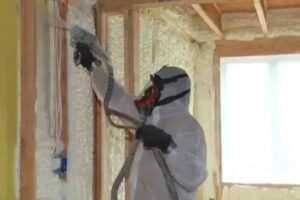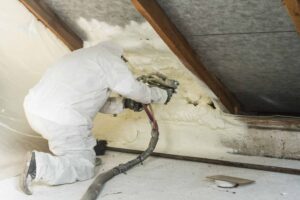Progressive builders increasingly choose spray foam insulation for new construction because it creates an air-tight thermal envelope that significantly outperforms traditional insulation methods. This single solution addresses multiple building challenges by delivering superior energy efficiency (reducing costs by 20-40%), preventing moisture problems, enhancing structural strength, and meeting stringent building codes—all while allowing more design flexibility. As energy prices rise and building standards tighten, spray foam’s ability to create high-performance buildings with fewer materials and steps gives forward-thinking builders a competitive edge.
The modern construction landscape values long-term performance over initial cost alone. Spray foam insulation fits this shift perfectly by allowing builders to create structures with smaller HVAC systems, fewer air leaks, and better overall building durability. These benefits translate to happier clients, fewer callbacks, and better reputations in an increasingly conscientious construction market.
Performance Advantages of Spray Foam
| Feature | Traditional Insulation | Spray Foam Insulation | Advantage |
|---|---|---|---|
| Air Sealing | Separate air barrier needed | Insulation and air barrier combined | Reduces labor, ensures complete seal |
| R-Value Stability | Degrades over time | Maintains R-value for life of building | Long-term energy performance |
| Moisture Management | Susceptible to moisture damage | Resists water absorption | Prevents mold and structural damage |
| Installation Speed | Multiple steps, contractors | One application, one contractor | Faster project completion |
| Coverage | Gaps at framing, penetrations | Complete coverage of all surfaces | No thermal bridging or leaks |
| Structural Support | No structural benefit | Adds 250-300% racking strength | Enhanced durability and resilience |
Energy Performance Benefits
Modern spray foam creates an uninterrupted thermal barrier that eliminates the energy leaks common with traditional insulation. This comprehensive air seal prevents the stack effect that pulls conditioned air out of buildings while allowing outside air to infiltrate.
According to recent market data, homes insulated with spray foam use 30-50% less energy for heating and cooling compared to identical homes with fiberglass insulation. This translates to smaller HVAC equipment requirements and dramatically lower operational costs over the building’s lifetime.
Moisture Control Capabilities
Spray foam’s closed-cell structure blocks water vapor transmission while its adhesive properties seal gaps where condensation typically forms. This moisture control:
- Prevents mold growth in wall cavities
- Protects structural elements from rot and decay
- Eliminates conditions for pest infestation
- Maintains indoor air quality
Bonus Tip: In mixed humid climates, specify closed-cell spray foam for exterior walls and foundation areas to create a Class II vapor retarder. This strategy eliminates the need for additional vapor barrier materials while providing optimal moisture protection.
Design Flexibility Advantages
The expansive, adhesive nature of spray foam allows builders to insulate complex architectural features that challenge traditional insulation methods:
- Cathedral ceilings and complex roof designs
- Curved walls and non-standard angles
- Floor cantilevers and overhangs
- Difficult-to-access areas
This flexibility enables architects to create more interesting and energy-efficient designs without compromise.
Technical Specifications of Spray Foam Types
| Property | Open Cell Spray Foam | Closed Cell Spray Foam |
|---|---|---|
| Density | 0.5-0.8 lb/cu ft | 1.8-2.3 lb/cu ft |
| R-value per inch | 3.6-3.9 | 6.0-7.0 |
| Air Barrier Threshold | 3.5 inches | 1.0-1.5 inches |
| Water Vapor Permeance | 5.0-5.5 perms @ 5″ | 0.8-1.2 perms @ 2″ |
| Compressive Strength | 0.4-0.5 psi | 25-30 psi |
| Sound Dampening | Superior | Good |
| Typical Application | Interior walls, ceilings | Exterior walls, foundations |
| Installation Cost | $1.00-$1.50 per board foot | $1.50-$2.50 per board foot |
Application Strategy in New Construction
Progressive builders strategically deploy different spray foam types throughout new buildings:
- Closed-cell foam for foundation walls, rim joists, and exterior walls
- Open-cell foam for interior walls and roof assemblies
- Targeted high-density applications for sound control between floors
This tailored approach maximizes performance while optimizing construction budgets.
Building Code Compliance Benefits
Modern building codes continue to increase energy efficiency requirements. The International Energy Conservation Code (IECC) now mandates:
- Continuous air barriers
- Higher R-values for all climate zones
- Blower door testing for air tightness
- Thermal bridge mitigation
Spray foam helps builders meet these requirements with a single application, often exceeding minimum standards and preparing buildings for future code updates.
Construction Process Advantages
Spray foam installation integrates seamlessly with modern construction sequencing:
- Applied after rough-in but before drywall
- Single-trade installation instead of multiple insulation steps
- Fewer inspection points and quality control issues
- Faster building enclosure, allowing interior work to begin sooner
Recent surveys show progressive builders reduce overall construction time by 5-7 days on typical residential projects when using spray foam insulation systems.
Bonus Tip: Schedule spray foam installation during mild weather conditions (50-90°F) for optimal application quality. When building year-round, create temporary enclosed environments with controlled temperatures for winter applications.
Economic Benefits for Builders
| Benefit Category | Traditional Building Approach | Spray Foam Approach | Impact on Builder |
|---|---|---|---|
| HVAC Sizing | Standard sizing based on square footage | 20-30% reduction in tonnage | Lower equipment costs, higher profit margins |
| Callbacks | Common for comfort issues | Reduced by up to 70% | Higher customer satisfaction, less warranty work |
| Build Speed | Multiple trades for insulation and air sealing | Single application | Faster project turnover, improved cash flow |
| Green Building Certification | Requires multiple systems and products | Single system contributes to multiple credits | Easier certification process, marketing advantage |
| Market Differentiation | Standard performance metrics | High-performance statistics | Premium positioning, higher sale prices |
A 2024 construction industry analysis found that builders offering spray foam insulation command a 4-7% price premium on new homes while experiencing 70% fewer post-construction comfort complaints.

Things to Consider Before Making a Decision
Project Type and Budget Alignment
Different project types benefit differently from spray foam:
- High-end custom homes: Comprehensive spray foam throughout
- Production homes: Strategic spray foam in critical areas combined with traditional insulation
- Multi-family: Spray foam for exterior envelope and between units for sound control
Carefully evaluate where spray foam delivers the most value for your specific project type and price point.
Skilled Applicator Availability
Quality application requires specialized equipment and trained technicians. Before committing to spray foam:
- Verify certified installer availability in your building area
- Check installer credentials and project history
- Confirm scheduling alignment with your project timeline
- Request references from other builders
Climate Zone Considerations
Spray foam performs differently in various climate zones:
- Cold climates: Focus on air sealing and high R-value
- Hot-humid climates: Moisture control and air conditioning efficiency
- Mixed climates: Seasonal adaptability and indoor humidity management
Select foam types and application strategies optimized for your specific building location.
Spray Foam in New Construction FAQ
How does spray foam impact other trades during construction?
Spray foam requires clear communication with plumbing, electrical, and HVAC contractors. All rough-in work must be complete and inspected before foam application. Most progressive builders schedule spray foam as a distinct phase, clearing the building of other trades during application and for 24-48 hours afterward during the curing period.
Does using spray foam affect project financing or appraisals?
Increasingly, yes—positively. Many lenders now offer energy-efficient mortgage products that recognize the long-term value of high-performance insulation. Home appraisal standards have evolved to include energy efficiency factors, with HERS ratings and projected energy costs increasingly factored into valuations. Documentation of spray foam use can support higher appraised values.
How do builders verify proper spray foam installation?
Progressive builders use several quality control measures including:
- Thickness gauges to verify proper application depth
- Visual inspection of coverage before drywall
- Infrared thermal imaging to identify any missed areas
- Blower door testing to confirm air sealing performance
These verification steps ensure the promised performance benefits are actually delivered.
What training do construction teams need for spray foam projects?
While the actual foam application requires certified professionals, general construction crews need education on:
- Not cutting or damaging foam after application
- Proper sequencing of trades before and after foam installation
- Safe work practices around curing foam
- How to coordinate with foam contractors for optimal results
Many spray foam manufacturers offer free training sessions for construction teams.
How does spray foam contribute to green building certifications?
Spray foam directly contributes to multiple certification criteria including:
- Energy efficiency points (LEED, ENERGY STAR, National Green Building Standard)
- Indoor air quality credits by reducing infiltration of outdoor pollutants
- Innovation credits when used as part of advanced building envelope systems
- Material efficiency when allowing downsized HVAC and structural elements
These contributions simplify the certification process compared to assembling multiple conventional systems.
Make the Right Decision
Progressive builders choose spray foam because it aligns perfectly with modern construction priorities: energy efficiency, building durability, occupant comfort, and simplified construction processes. The initial investment delivers substantial long-term returns through better building performance and market differentiation.
Consider your specific project goals, climate requirements, and customer expectations when deciding where and how to incorporate spray foam. Most successful builders start with critical applications like rim joists and attics before expanding to whole-house implementation as they gain experience with the technology and its benefits.
